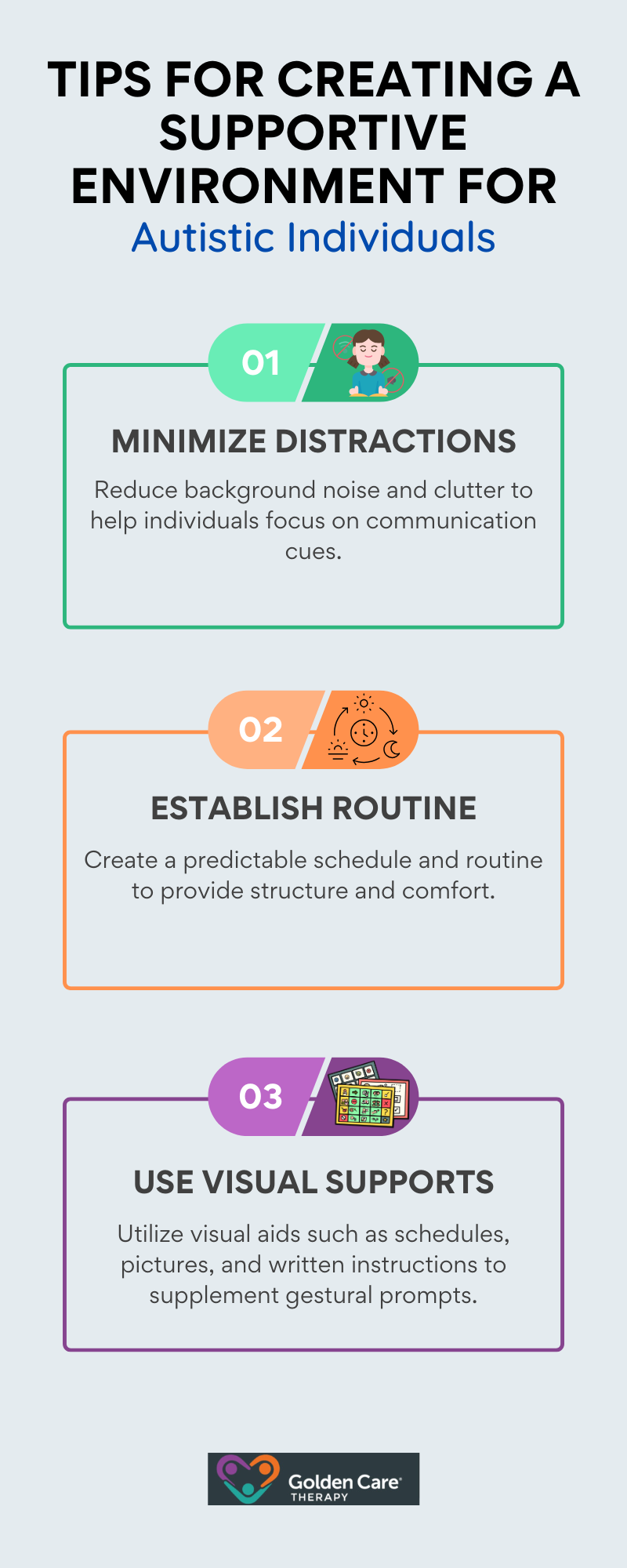Gestural prompts refer to non-verbal cues and signals used to guide individuals toward desired behaviors or responses. These prompts involve physical gestures, hand movements, facial expressions, or other visual cues to help individuals understand what is expected of them in a specific situation.
Gestural prompts are particularly beneficial for individuals with autism who may have challenges with verbal communication.
In autism therapy, gestural prompts play a crucial role in facilitating communication, understanding social cues, and promoting language development. For individuals on the autism spectrum, who may struggle with verbal communication or have difficulty interpreting social signals, gestural prompts serve as valuable tools to enhance their ability to communicate effectively.
Types of Gestural Prompts
As mentioned, gestural prompts play a crucial role in facilitating communication and understanding. That said, let’s take a look at the different types of gestural prompts commonly used in therapy sessions, often identified through a functional analysis of individual needs and behaviors.

Physical Gestures
Physical gestures involve using body movements to convey a message or prompt a response. These gestures can include pointing, nodding, waving, or other forms of physical cues. Physical gestures are effective in providing visual support and guidance to individuals with autism, helping them comprehend and respond to instructions more easily.
Hand Movements
Hand movements are another form of gestural prompts that can aid in communication and interaction. Hand movements may include gestures like clapping, showing thumbs up, or creating signs to convey specific meanings. By incorporating hand movements into therapy sessions, therapists and caregivers can enhance engagement and encourage participation from individuals with autism.
Facial Expressions
Facial expressions play a significant role in nonverbal communication and emotional expression. When used as gestural prompts, facial expressions can help convey feelings, intentions, and social cues to individuals with autism.
Smiling, frowning, raising eyebrows, and other facial expressions serve as valuable prompts to encourage social interaction and understanding in therapy settings.
Utilizing a combination of physical gestures, hand movements, and facial expressions in ABA therapy can enhance communication skills, promote social interaction, and foster language development in individuals with autism.
How to Implement Gestural Prompts Effectively
In terms of utilizing gestural prompts in Applied Behavior Analysis (ABA) therapy for individuals with autism, effective implementation is key to promoting communication and learning.
Let’s look at the importance of individualizing gestural prompts, maintaining consistency in their use, and providing reinforcement and feedback to enhance the effectiveness of these prompts.
Individualizing Gestural Prompts
Individualizing gestural prompts involves tailoring the prompts to suit the unique needs and preferences of the individual with autism. It is essential to consider the individual’s communication style, sensory sensitivities, and understanding level when selecting and using gestural prompts.
Personalizing the prompts makes it easier for therapists and caregivers to increase the likelihood of the individual responding positively and engaging in meaningful interaction.

Consistency in Using Gestural Prompts
Consistency in the use of gestural prompts is crucial for reinforcing learning and promoting communication skills in individuals with autism. By consistently incorporating gestures into daily interactions and therapy sessions, individuals can become accustomed to the prompts and learn to associate them with specific actions or requests.
Consistent use also helps in establishing routines and expectations, creating a sense of predictability and security for the individual.
Reinforcement and Feedback
Providing reinforcement and feedback is an essential component of effective gestural prompt implementation. Positive reinforcement, such as verbal praise, rewards, or preferred activities, can motivate individuals to respond to gestural prompts and communicate effectively.
It is important to offer immediate feedback and reinforcement when the individual successfully follows a gestural prompt to strengthen the desired behavior.
In ABA therapy, reinforcement and feedback play a significant role in shaping behavior and increasing the likelihood of desired outcomes. By consistently applying reinforcement strategies and offering constructive feedback, therapists and caregivers can support individuals with autism in developing their communication skills and achieving meaningful progress in their therapy journey.
Tips for Using Gestural Prompts at Home
To incorporate gestural prompts into daily interactions at home, a supportive environment should be in place to facilitate effective communication with individuals with autism. By incorporating gestural prompts strategically and consistently, caregivers can help enhance social interaction and language skills.
That said, here are some essential tips for utilizing gestural prompts in a home setting:
Create a Supportive Environment
Ensuring that the home environment is conducive to effective communication is essential when using gestural prompts with individuals with autism. Here are some practical tips to create a supportive environment:

Incorporate Gestural Prompts in Daily Interactions
Integrating gestural prompts into daily interactions can help individuals with autism understand and respond effectively. Here are some ways to incorporate gestural prompts into everyday routines:
- Encourage Imitation: Model gestures and encourage individuals to imitate your actions to promote learning.
- Use Simple Gestures: Start with basic gestures and gradually introduce more complex prompts as skills improve.
- Provide Clear Instructions: Use gestures alongside verbal cues to reinforce understanding and facilitate communication.
Practice Patience and Persistence
Patience and persistence are essential when using gestural prompts with individuals with autism. It is important to remain consistent and positive throughout the process. Here are some tips for practicing patience and persistence:
- Celebrate Progress: Acknowledge and celebrate small achievements to encourage continued efforts.
- Repeat and Reinforce: Repetition is key to learning, so continue to practice gestural prompts consistently.
- Stay Calm: Maintain a calm and supportive demeanor, even during challenging moments, to create a positive learning environment.
Through the use of these strategies, caregivers can effectively utilize gestural prompts to enhance communication skills and enhance social interaction for individuals with autism at home.
Through consistent practice and a nurturing approach, individuals with autism can develop their language skills and improve their overall communication abilities. At Golden Care Therapy ABA, we are committed to providing personalized ABA services that foster meaningful progress and help individuals thrive.
Our team of dedicated professionals works closely with each individual to create customized plans that address their unique needs. Whether you’re seeking ABA therapy in Indiana, New Jersey, New York, Georgia, or Florida, we are here to support your journey.
Don’t hesitate to contact us today to learn how our expert services can make a difference in your loved one’s life.
Sources:



